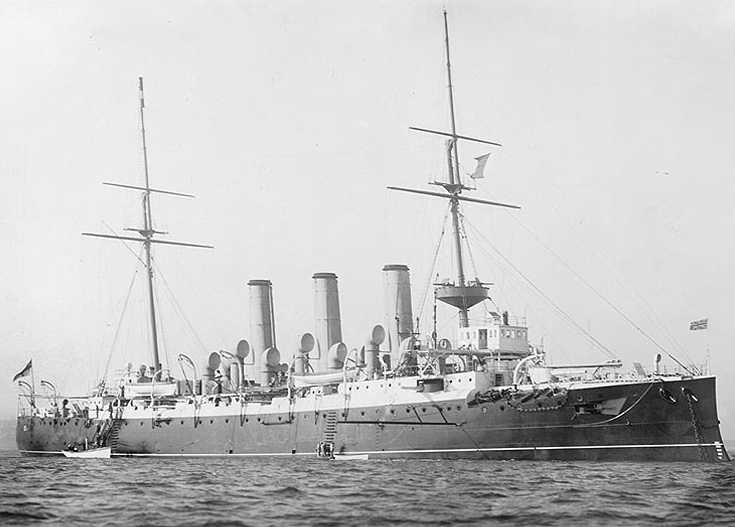
Guns of this caliber were manufactured for both the Navy and the Army, with many transfers taking place between the services. The Army used them for coastal defense batteries and as field armament, with special gun carriages being built to handle the trunnions.
All of these guns were of built up construction and generally similar. Of the Elswick guns in British service, the Mark I was an Elswick Pattern "P", Mark II was Pattern "Q" and Mark III was Pattern "T". Mark I was constructed of A tube, jacket, five B hoops to the muzzle, screwed securing ring and breech ring. The interrupted screw breech block with conical fore part was taken by the jacket. Mark II differed principally in having three B hoops and a short C hoop screwed to the jacket. Mark III differed by having a B hoop, two B tubes and a shorter C hoop. Mark IV was partially wire wound with B tube, jacket, very short C hoop and breech ring. The breech block was taken by a breech bush screwed into the A tube. All Marks originally used a three-motion screw breech.
Weapons designated with the letter "A" indicated a modification to the three-motion breech mechanism while the letter "B" indicated a conversion to a single motion breech mechanism. British naval guns that had the breech ring altered to suit Army field mountings were given a single star in the designation. Guns with two stars are believed to have been further altered to add a cartridge retaining catch in order to allow HA fire. In the early part of World War I, ten guns were removed from the Latona class minelayers, adapted for AA fire and then assigned to the London defenses. These appear to have been ineffective in that role.
154 Mark I, 91 Mark II, 338 Mark III and 584 Mark IV were manufactured. 776 of these guns were built specifically for the Navy and an additional 110 were transferred to the Navy from the Army. During World War I Japan transferred to Britain 13 Mark IVJ guns (the J presumably being for "Japan") and 24 stock (Elswick) guns. Australia had an additional 13 guns which were not numbered in the British series; these may have been export guns such as those made by Elswick. Apart from some coastal defense batteries, none of these guns survived in service by 1939.
The Mark VI designation was given to Army QF Marks I to IV guns converted to using a bag charge with a 3-inch (7.62 cm) obturation case, some built of steel. This modification was to reduce the need for brass cartridge cases and it was hoped to improve accuracy. However, this gun does not appear to have been very successful. A total of 83 guns of this type were acquired for use on minor DAMS during World War I and at least one of these was purchased by Spain in 1937, as shown in the photographs below.
An Elswick Type gun of similar design was sold to Japan in the latter part of the 19th century. Japan obtained a license and then produced more of these weapons. As noted above, some 37 of these were sent to Britain during World War I. Japanese guns were redesignated as 41st Year Type on 25 December 1908. Redesignated in centimeters on 5 October 1917.
The Italian firm of Ansaldo purchased many of these guns for secondary weapons on their armored cruisers built around 1900. During World War II, the Italians employed a few as star-shell guns on capital ships.
Actual bore diameter of all British 4.7" guns was 4.724" (12 cm).
Unless otherwise noted, the data below is for British Mark I to IV guns.
| Designation | Britain
4.7-inch (12 cm) Elswick 4.7-inch (12 cm) QF Marks I, II, III, IV and VI Italy
Japan
|
|---|---|
| Ship Class Used On | Britain: Pre-dreadnoughts and cruisers of the late 1800s
Italy: Cruisers of the late 1800s - early 1900s Japan: Cruisers and destroyers of the early 1900s All 4.7" (12 cm) guns in the Royal Navy as of 1914 were Mark I to Mark IV Types World War I
|
| Date Of Design | about 1885 |
| Date In Service | 1887 (on British ships) |
| Gun Weight | 2.07 - 2.1 tons (2.1 - 2.2 mt) |
| Gun Length oa | 194.1 in (4.930 m) |
| Bore Length | 189 in (4.801 m) |
| Rifling Length | N/A |
| Grooves | N/A |
| Lands | N/A |
| Twist | N/A |
| Chamber Volume | Marks I, II, III and IV: 284 in3 (4.66 dm3)
Mark VI: 490 in3 (8.04 dm3) |
| Rate Of Fire | about 5 - 6 rounds per minute 1 2 |
- ^Quoting from a New York Times article of 26 October 1893: "So far as is known, the Armstrong 4.724-inch gun has never attained a rapidity of fire greater than twelve rounds per minute of unaimed shots. When aimed from a gunboat in motion, there is required for 10 rounds 1 minute and 38 seconds." This latter figure is equivalent to about 6 rounds per minute.
- ^Trials of the new 4.7"/40 (12 cm) QF guns on HMS Trafalgar in the early 1890s showed that they could fire ten unaimed shots in 80 seconds, or about 7 rounds a minute. Nonetheless, these guns were replaced on Trafalgar and sister-ship HMS Nile with 6" (15.2 cm) QF guns in 1896 - 1897.
| Type | Separate |
|---|---|
| Projectile Types and Weights 1a | Common, AP, HE, CP, Shrapnel - 45 lbs. (20.4 kg) |
| Bursting Charge | Common - 6.84 lbs. (3.1 kg)
Others - N/A |
| Projectile Length | N/A |
| Propellant Charge | British
12.0 lbs. (5.4 kg) SP 5.44 lbs. (2.5 kg) Cord 20 6.45 lbs. (2.9 kg) MD16 Others
|
| Muzzle Velocity 2a | British
SP - 1,786 fps (544 mps) Cord - 2,125 fps (648 mps) MD - 2,215 fps (675 mps) Japanese
|
| Working Pressure 3a | For a MV of 2,100 fps (640 mps) - 12.4 ton/in2 (1,955 kg/cm2)
For a MV of 2,265 fps (690 mps) - 14.8 ton/in2 (2,333 kg/cm2) For a MV of 2,436 fps (742 mps) - 18.0 ton/in2 (2,837 kg/cm2) |
| Approximate Barrel Life | N/A |
| Ammunition stowage per gun | N/A |
- ^The proper shell weight for these guns was a much argued subject in Britain. The Elswick Pattern M fired 36 lbs. (16.3 kg) projectiles, but the Mark I fired 40 lbs. (18.1 kg) projectiles. At the Admiralty's request, this was reduced to 30 lbs. (13.6 kg) but then increased to 36 lbs. (16.3 kg), later to 40 lbs. (18.1 kg) and finally to 45 lbs. (20.4 kg).
- ^The above muzzle velocities are for the Mark I through Mark IV guns. The Mark VI gun used a 6.25 lbs. (2.83 kg) MD11 charge giving it a muzzle velocity of 2,203 fps (671 mps).
- ^The above Working Pressure values are for an Elswick gun purchased by the USA for test purposes in 1893. 2,436 fps (742 mps) was the muzzle velocity used for proof testing.
| Elevation | With HE Shell and MD Charges |
|---|---|
| Elevation | With 45 lbs. (20.4 kg) HE Shell |
| Range @ 20 degrees | 9,900 yards (9,050 m) |
| Range | Side Armor of Wrought Iron | Deck Armor |
|---|---|---|
| 0 yards (0 m) | 11.7" (297 mm) | --- |
This data from "Getting Ready for the Test: Heavy Calibre Rapid-Fire Guns Arrive at the Sandy Hook Proving Ground" article in The New York Times of 26 October 1893. Muzzle velocity for these tests was 2,100 fps (640 mps).
| Designation | Single Mounts 1b Britain
World War I: PIII, PIV and PIV* For Mark VI guns: PVII, PVIII and CPIX Japan
|
|---|---|
| Weight | about 8 tons (8.1 mt) |
| Elevation | BDI and BDII: -3 / +15 degrees
Others: -3 / +20 degrees |
| Elevation Rate | Manually operated, only |
| Train | Open mounts: 360 degrees
Casemate mounts: About +30 to +150 degrees |
| Train Rate | Manually operated, only |
| Gun recoil | N/A |
- ^The PVII was a modified Army cradle for 4" (10.2 cm) PII or PII* mountings. The PVIII was a modified Army cradle for 4" (10.2 cm) PX mountings. Japanese mountings were supplied from Elswick with the guns. Coastal defense mountings were generally similar to GII and PIV types.
- Many of these guns on British warships were replaced by 6" (15.2 cm) guns during the rearmament programs of the late 1890s and early 1900s.
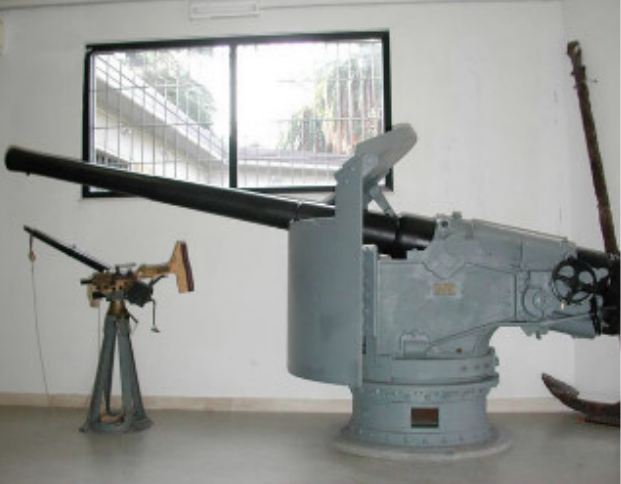
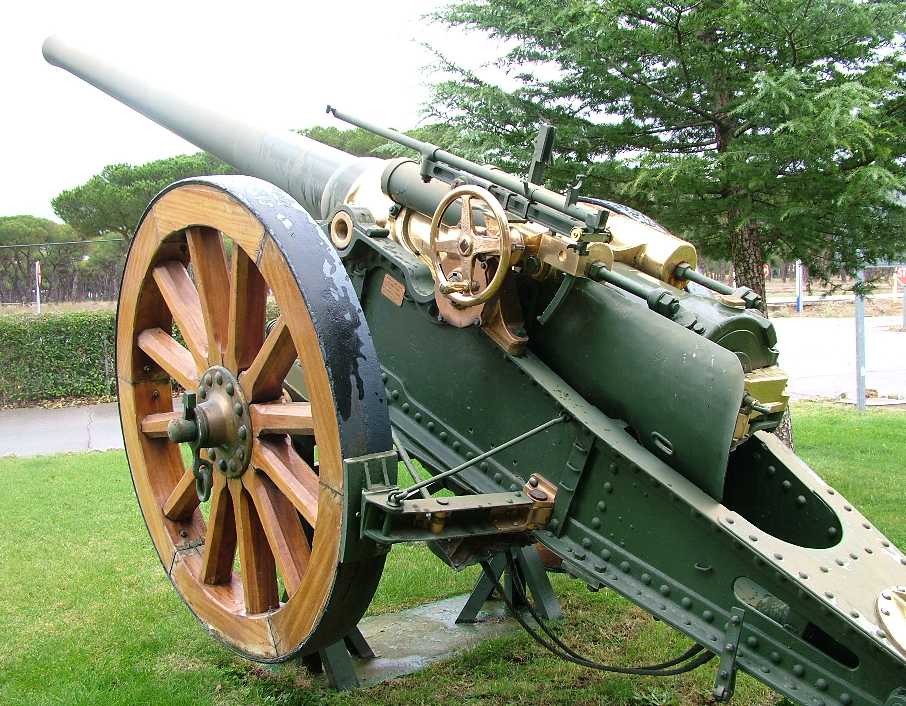
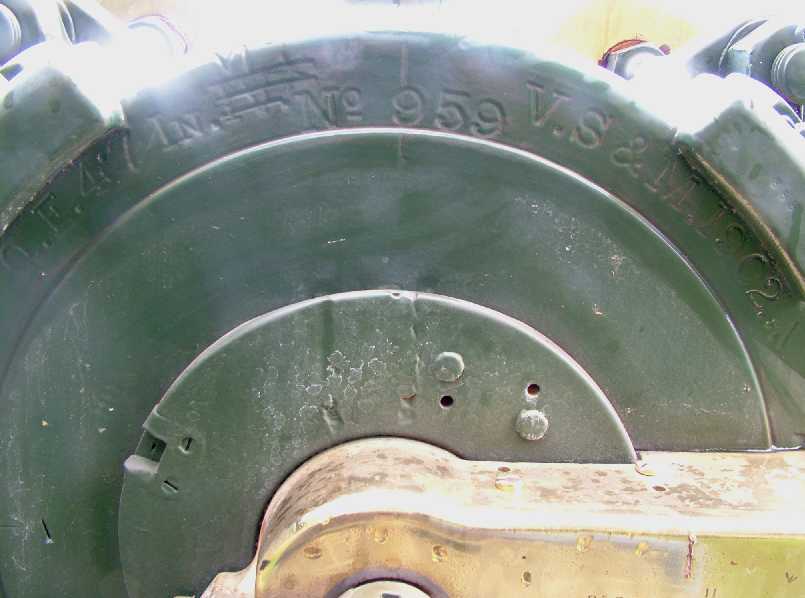
Q.F. 4.7 In. VI/IV* V.S & M 1902 No 959
Where:
Q.F. 4.7 In. VI/IV* = Quick Firing 4.7 inch Mark IV* converted to Mark VI. Note that the "IV*" has been crossed out and a "VI" inscribed above it, showing that this was one of the guns modified to use a short obturation case.
V.S & M. 1902 = Built at Vickers Sons and Maxim in 1902
No 959 = Serial Number 959
Photograph copyrighted by Javier Villarroya del Real.
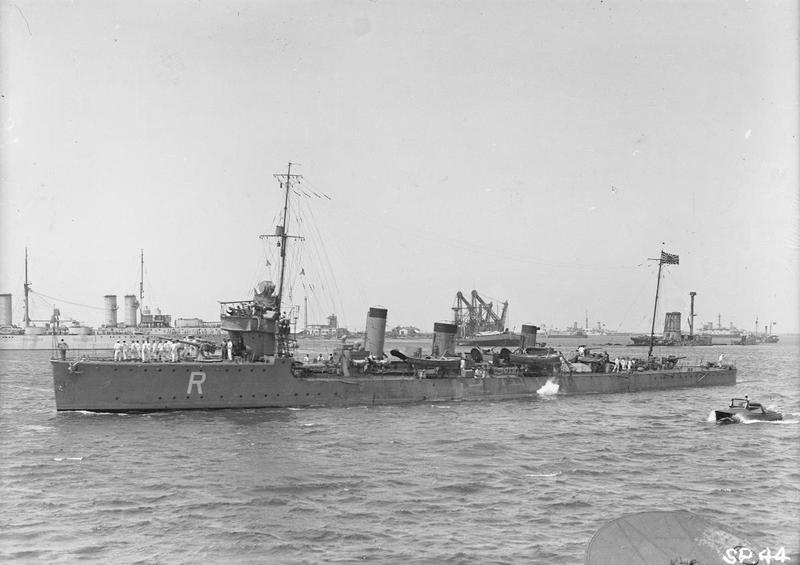
"Naval Weapons of World War Two" and "British Naval Guns 1880-1945 No 15" article in "Warship Volume IX" both by John Campbell
"US Naval Weapons" and "US Cruisers: An Illustrated Design History" both by Norman Friedman
"Cruisers of the Royal and Commonwealth Navies" by Douglas Morris
"Japanese Cruisers of the Pacific War" by Eric Lacroix and Linton Wells II
"British Battleships: 1860 - 1950" by Oscar Parkes
---
"Getting Ready for the Test: Heavy Calibre Rapid-Fire Guns Arrive at the Sandy Hook Proving Ground" article in The New York Times of 26 October 1893
---
Special help from Anthony G. Williams and Shane Rogers
Other images at The
Vickers Photographic Archive
See photographs 6485
and 6683
---
Other images at Australian War Memorial
See photographs J02937,
P00295.221,
P00653.103,
P00653.111,
060050
and 4.7 Gallipoli
19 October 2008 - Benchmark
03 January 2009 - Removed reference to USS New Orleans Class Cruisers
08 February 2009 - Added information about Australian guns, added information to "Ship Class Used On" section, added chamber volume of Mark VI, added British mount usage information, added
information about Japanese mountings, comment about Pattern "M" on Italian ships
29 August 2011 - Added mounting information for Trafalgar and Bafleur classes
25 December 2011 - Corrected typographical error
23 September 2012 - Added picture of Italian gun
14 July 2014 - Added additional pictures datapage, use on Japanese destroyers and miscellaneous additional data
01 December 2015 - Changed Vickers Photographic Archive links to point at Wayback Archive
23 May 2016 - Changed to HTML 5 format
01 December 2021 - Reorganized notes
